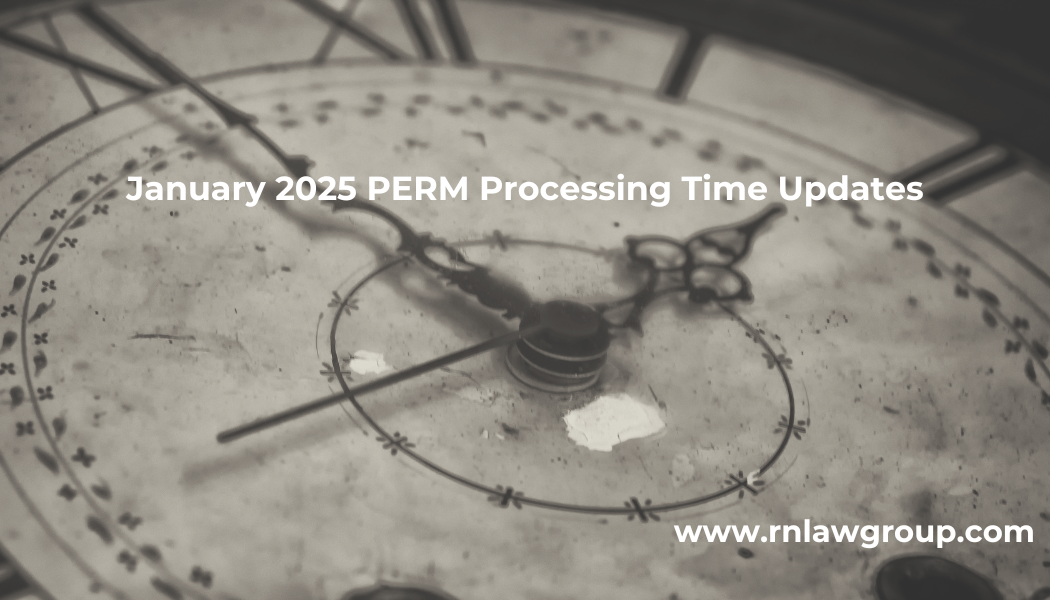
January 2025 PERM Processing Time Updates
The Department of Labor (DOL) issued updated PERM processing times as of January 01, 2025 for PERM applications and prevailing wage determinations (PWD). These updates provide important information for employers and foreign workers navigating the employment-based green card process. Processing times directly impact how employers and foreign workers plan for each stage, from filing the initial PERM application to submitting the I-140 immigrant petition and ultimately, when the priority date is current, applying for adjustment of status or consular processing. Staying informed allows for better coordination of resources and preparation for delays. Moreover, anticipating processing timelines helps manage expectations, avoid lapses in work authorization, and maintain compliance with immigration regulations, ensuring a smoother and more efficient process.
January 2025 Updated PWD and PERM Processing Times
The National Prevailing Wage Center (NPWC) is processing PWDs that were filed in June 2024 for both OES wages (standard) and non-OES wages, which includes private wage surveys. Further, the NPWC is processing redetermination requests submitted in June 2024. Currently at Reddy Neumann Brown PC, we are seeing PWDs being issued in about 6 months.
The DOL is processing PERM applications filed in September 2023. On average, the DOL is adjudicating PERM applications in approximately 462 days (if no audit is issued). There appears to be no data provided by the DOL in this January update for PERM applications that have been audited. However, based on last months’ update, DOL stated the agency was processing audits for PERM applications that were filed in December 2022, with an average total processing time of 496 days. Also, the DOL is processing PERM reconsideration requests that were submitted in July 2024. Currently at Reddy Neumann Brown PC, we are seeing PERM applications approved (if not audited) in approximately 14 to 15 months, which is consistent with the average processing times reported by the DOL.
What to Expect Moving Forward
Over the past few years, PERM processing times have continued to increase significantly. Based on this trend, there is little expectation that processing times will improve considerably in the near future. To mitigate these delays, it is crucial to begin the green card process as early as possible to account for processing delays.
Although the DOL has implemented the Foreign Labor Application Gateway (FLAG) system with efficiencies designed to streamline processes, it remains unclear whether these measures will result in significant reductions in processing times. The DOL has acknowledged the current delays and continues to explore improvements. While some progress has been made with reducing processing times for PWDs, reductions for PERM applications may prove difficult.
In FY2024, the DOL stated that it experienced a 12% increase in total filings compared to the previous year, adding strain to an already burdened system. This surge in demand highlights the importance of starting early and preparing for potential delays, as the increased volume will likely continue to impact timelines in the foreseeable future. Employers and foreign workers should plan strategically and monitor updates to navigate this complex process effectively.
Alternative Options
Employers should initiate the PERM-based green card process as early as possible to avoid issues related to the foreign worker’s temporary work visa status. Moreover, individuals who qualify may explore alternative avenues to the PERM-based green card process. When considering alternatives to the PERM-based green card process, several immigrant visa categories offer potential pathways that may be quicker or more suitable for certain individuals and employers.
- EB-1A Extraordinary Ability
- EB-1B Outstanding Professors and Researchers
- EB-1C for Multinational Managers or Executives
- EB-2 National Interest Waiver (NIW)
- “Schedule A” Group II Exceptional Ability
- EB-5 Immigrant Investor Program
While the PERM-based green card process has traditionally been a main pathway for individuals seeking permanent employment in the U.S., exploring alternative options can present practical and faster routes for both individuals and employers. The wide range of available immigrant visas accommodates various skill levels and business needs, offering flexibility in navigating the complexities of U.S. immigration laws. By understanding and considering these alternatives, individuals and organizations can make more informed decisions about their immigration options.
As an immigration law firm that has been serving our clients for over 25 years, our team is here to offer prompt, practical, and professional advice, whether you’re a company seeking to hire top talent to grow your business or a foreign worker wanting to develop a career in the United States. If you have any questions, please schedule a consultation with one of our attorneys at https://appointments.rnlawgroup.com/.
By : Krystal Alanis
Krystal Alanis is a Partner at Reddy Neumann Brown PC and manages the firm’s PERM Labor Certification Department, where she oversees all EB-2 and EB-3 employment-based green card matters. Krystal guides clients from a variety of industries through the maze of the PERM Labor certification process and has handled thousands of PERM applications throughout her career with Reddy Neumann Brown PC. Krystal also guides employers and individuals through the I-140 and Adjustment of Status process, and assists clients with temporary work visa petitions (e.g., H-1B, TN, L-1, E-2). With over 13 years of immigration experience, Krystal is able to advise her clients with confidence and recognize any potential pitfalls that may arise.

